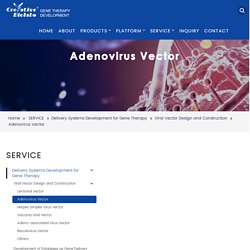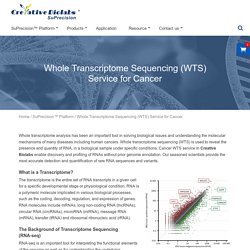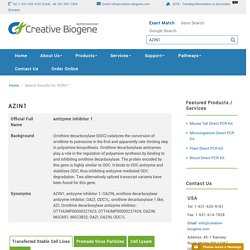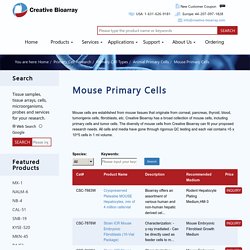

FDA Emergency Use Authorized Coronavirus (COVID-19) Instant Test Kit – How to Sell CBD Online. Creative Biolabs 2020. Adenovirus Vector. For lab research use only, not for human therapeutic use.

Cancer gene therapy requires introducing new genetic material into target cells through an effective vector without toxicity to non-target tissues. Adenoviral vectors are good candidates for direct in vivo gene transfer. The world's first licensed gene therapy product is based on the adenovirus as a gene delivery vector. Creative Biolabs provides the state-of-the-art adenoviral vector with the various design and construction to meet the demand in basic research and preclinical applications.
Adenovirus Vector Construction Adenoviruses are nonenveloped viruses with an icosahedral protein capsid consisting of a linear double-stranded DNA genome. Fig.1 Adenovirus vector construction for gene therapy The vector is chemically modified with a polymer after production and purification, so as to eliminate the barrier presented by the vector-host interaction. Adeno-associated Virus Vector.
For Lab Research Use Only, Not for Human or Animal Therapeutic Use.

Introducing new genetic material into target cells without causing toxicity to non-target tissues is the goal of cancer gene therapy. The adeno-associated virus (AAV) is a small virus that allows packaging of only 4 kb inserts. AAV has low toxicity, apparent lack of pathogenicity and provides long-term transgene expression through chromosomal integration. Using the basic principles of molecular biology and laboratory techniques, Creative Biolabs provides a wide variety of AAV vectors for both basic research and clinical applications.
Adeno-associated Virus Vector Construction The AAV genome contains two genes, rep and cap, encoding polypeptides essential for the replication and encapsidation of AAV.
*Creative Biolabs* Oncolytic Virus Therapy Development. Oncolytic virotherapy is a cancer treatment using a native or reprogrammed virus that has the potential to targeting and killing cancerous cells.

Since the first attempt of using virus to treat tumor patient in 1900s, oncolytic virus has been extensively and deeply studied in the field of virotherapy for over one hundred years as a promising therapeutic. Benefiting from the development of recombinant DNA technology, a dramatic progress has been made on oncolytic virus field. Taking advantage of the OncoVirapy™ platform, Creative Biolabs provides customized, standardized, reliable and high-quality oncolytic virus therapy development services for clients globally.
Cargo Loading into Exosomes. The natural complex composition of exosomes has made them attractive for use as therapeutic shuttles to deliver biological molecules or drugs to target disease cells.

To facilitate the applications of exosomes in therapeutics and other possible uses, Creative Biolabs is offering unparalleled exosome engineering services that enable loading of nucleic acids, proteins, and small molecules into or onto exosomes. Exosomes naturally carry various types of proteins, lipids, and nucleic acids (mRNA and non-coding RNA), playing a vital role in cell-to-cell communication. Furthermore, exosomes exhibit desirable features of an ideal drug delivery system, such as a high delivery efficiency, long circulating half-life, the intrinsic ability to target tissues, biocompatibility, and minimal or no inherent toxicity issues. Fig.1 Composition of exosomes. (Ha, 2016) siRNA is used to disrupt genes of interest in genetic therapy. Whole Transcriptome Sequencing Service for Cancer. Whole transcriptome analysis has been an important tool in solving biological issues and understanding the molecular mechanisms of many diseases including human cancers.

Whole transcriptome sequencing (WTS) is used to reveal the presence and quantity of RNA, in a biological sample under specific conditions. Cancer WTS service in Creative Biolabs enable discovery and profiling of RNAs without prior genome annotation. Our seasoned scientists provide the most accurate detection and quantification of rare RNA sequences and variants.
What is a Transcriptome? Fig 1. The transcriptome is the entire set of RNA transcripts in a given cell for a specific developmental stage or physiological condition. The Background of Transcriptome Sequencing (RNA-seq) RNA-seq is an important tool for interpreting the functional elements of the genome as well as for understanding the underlying mechanisms of diverse diseases, especially cancers. AZIN1. Official Full Name antizyme inhibitor 1 Background Ornithine decarboxylase (ODC) catalyzes the conversion of ornithine to putrescine in the first and apparently rate-limiting step in polyamine biosynthesis.

Ornithine decarboxylase antizymes play a role in the regulation of polyamine synthesis by binding to and inhibiting ornithine decarboxylase. The protein encoded by this gene is highly similar to ODC. Synonyms AZIN1; antizyme inhibitor 1; OAZIN, ornithine decarboxylase antizyme inhibitor; OAZI; ODC1L; ornithine decarboxylase 1 like; AZI; Ornithine decarboxylase antizyme inhibitor; OTTHUMP00000227423; OTTHUMP00000227424; OAZIN; MGC691; MGC3832; OAZI, OAZIN, ODC1L Related Links Anti-Enzyme Inhibitor 1 is a protein encoded by the AZIN1 gene in humans. Figure 1. AZIN1 upregulates intracellular polyamine levels, and high polyamine levels inhibit AZIN1 expression at both the transcriptional and posttranscriptional levels, forming a feedback regulatory loop. Mouse Primary Cells. Mouse cells are established from mouse tissues that originate from corneal, pancreas, thyroid, blood, tumorigenix cells, fibroblasts, etc.

Creative Bioarray has a broad collection of mouse cells, including primary cells and tumor cells. The diversity of mouse cells from Creative Bioarray can fit your proposed research needs. All cells and media have gone through rigorous QC testing and each vial contains >5 x 10^5 cells in 1 ml volume. Cat# Product Name Description Recommended Medium Price.